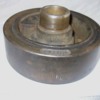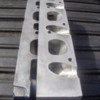Best of luck with your endeavor.
As far as rpm limitations on the track, here is a Youtube posted of a vintage 66 GT350 on the track at Daytonna.
The driver is clearly running the car to about 8,000 rpm in spots and isn't really even in the middle of the pack.
It is a 4 speed car, and of course the Pantera a 5 speed, so I don't know how that effects the rpm of the Pantera on the track?
In looking at the gear ratios 5th gear might only be able to be used on the big tracks that have long straightaways, like Daytonna.
It all depends on how hard the car will pull in 5th gear on the track.
On the smaller tracks, you might not even be able to get into 5th. I don't know, you will have to find that out for yourself, but I think you are going to need 8,000 rpm + capabilities to run with the pack with these guys.
The front runners are running the engine into the high 8,000's.
Here's the link to the video. The sound is great and you can hear the engine pretty clearly.
http://saacforum.com/index.php...;topicseen#msg203371There is a question also as to whether or not you can run this hard for long with the stock production block.
George is absolutely correct in that when the factory Gp4 cars were running, the parts development for racing the 351c was really just starting.
The casting numbers on the aluminum block and heads would indicate they were cast around January of 1968, and they were termed "Indy Project".
Where exactly they were for Detomaso is apparently "unobtainable".
It would appear that Don Nicholson and Gapp& Rousch were "given" those parts by Ford and Detomaso was not in the "preferred" group of recipients for any of those parts.
Warren Toppe was an original "purchaser" of one of the original Gp4 cars and it is that car that you see pictures of in and around Dearborn in 1972.
Warren got the car through his fathers connections since he was an engineer that worked for Ford.
The car originally came supplied with a 4 bolt production block which Warren quickly sent to it's ancestors in broken parts history.
It was Poppa Toppe that was responsible for the "competition" Cleveland block creation and casting through the Ford foundry which became complicated because this was during the exact period when Ford was shipping the specific mill for the Cleveland block to Australia.
BEFORE anyone called the racing Cleveland block the NASCAR or THE AUSTRALIAN BLOCK, it was referred to as the TOPPE BLOCK, even in the official Ford documents.
I was told by a reliable source that on the Ford tag the block came with, the tag was marked Toppe.
All of that was done so much on the fly because of the move to Australia, that it is said that the first Australian blocks still had the D2AE-CA (CA for Canada) on the block and the Ford logo "mint mark" near the oil pressure sender casting. It was Ford of Canada that somehow owned the "technical" rights to the block and it was them who sent the machinery to Australia, not Dearborn technically speaking.
Gee. I thought "Cleveland" was in the US?

Randy Gillis has some of the original Ford Engineering log books of the Ford FE and XE parts. Not all of them are racing parts but many are.
He can tell you the original casting dates, the dates of the revisions, and the Engineer who signed off on them.
It is really a job to research the specific changes and "technically correct" statements about these parts and kind of an academic exercise anyway.
He talks a lot about "funding" for each part, or which program paid for the part. It get's very technical and very complicated. Overly complicated often.
He also did mention something the other day about a "metallurgical designation" for adding nickle to the cast iron. I'm trying to remember, but...memory, yea right...I think it was something like "CA"?
That simply meant Ford added 5% more nickle into the metallurgical formula for the cast iron to strengthen it.
It was not something they liked to do because it made the block harder to machine.
I had one of those blocks as my first Cleveland build up in 1974 or 5 and when I went to pick it up from the shop the guy got all pissy and said don't ever come back here again with your "crap".
"That is some sort of special block and I had to resharpen the boring tool several times for each cylinder." That's what the shop said to me.
He then pointed to all of the x's and y's in the lifter valley. He said the other Cleveland blocks he had done did not have those.
He was wrong about those since at least all the D2AE-CA C's have them but who know's on the hardness of the block?
The Australian's claim they cast their blocks with more nickle? Who am I to disagree?
Sounds like I stumbled across one? Came out of a wrecked race Pantera too. I didn't think it was special at all.

Also on the valve springs, it doesn't really matter why the springs were failing now. The fact of the matter is that the metal used in the Cleveland springs was the same as that in other engines being raced.
If they broke in a Cleveland, but not in a Chevy or a Mopar, then I would think from an engineering standpoint, the cause might be elsewhere than the metal alloy? When I find the documentation on the oil bath solution to overheating springs in the Cleveland, I'll post it.
I didn't dream that one up. The only question in my mind is the time periods for this stuff. It really was all bad timing for Detomaso on 351c racing engine development. He was a little early to benefit from the Ford Racing program which the money was going to go into NASCAR priorities here in the 'States rather than into Europe which at that point Ford had little interest in for sports car racing.
NASCAR rules were eliminating the "Shotgun", which was the racing Boss 429 version and limiting the displacements down to slow the pace of the cars down for safety reasons.
As far as suggesting that Bud Moore being incompetent in building race engines, you are joking right? I hardly think that was the case. I personally wouldn't go there.
He has quite a good track record before this in Trans Am with the Boss 302's...among others.
That crank IS CREDITED WITH coming from "Hank the crank", and by that time he knew how to build competition internally balanced crankshafts.
Considering the internal politics of Ford at the time, I'm sure there were probably mitigating circumstances on delivering those "racing engines" to Detomaso?
I don't necessarily disagree with George's interpretation of the circumstances at all. It really is all water under the bridge but I do agree that you don't want to repeat that history with your car and spending extra money on at least a competition block and longevity modifications to the engine is going to reap immediate benefits to your long term racing program.
No one ever said it was going to be cheap to go racing at any level now.
Cobra Automotive gets $30,000 for a 600 hp 8,000rpm 292 engine now. The problem is that if you want to run at least in the MIDDLE of the pack, you need somewhere around 650 and 8,500 rpm capabilities AND...this is the killer...MORE THAN ONE ENGINE!
MANY have asked me why I don't race with those guys. Simple answer. I haven't won even one lottery yet! Some of us still need to hold down a full time job these days?

Best.




